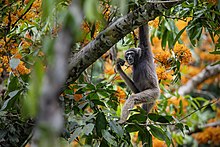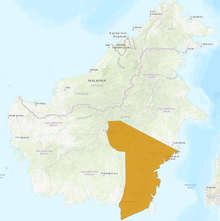| Müller's gibbon | |
|---|---|

| |
| Conservation status | |
 Endangered (IUCN 3.1) | |
| CITES Appendix I (CITES) | |
| Scientific classification | |
| Domain: | Eukaryota |
| Kingdom: | Animalia |
| Phylum: | Chordata |
| Class: | Mammalia |
| Order: | Primates |
| Suborder: | Haplorhini |
| Infraorder: | Simiiformes |
| Family: | Hylobatidae |
| Genus: | Hylobates |
| Species: | H. muelleri |
| Binomial name | |
| Hylobates muelleri Martin, 1841 | |

| |
| Müller's gibbon range | |
Müller's gibbon (Hylobates muelleri), also known as the southern grey gibbon, is a primate in the gibbon family, Hylobatidae.
Taxonomy
Formerly, the western grey gibbon (H. abbotti) and eastern grey gibbon (H. funereus) were considered conspecific with H. muelleri, but more recent studies indicate that all three are distinct species, and both the IUCN Red List and the American Society of Mammalogists consider them such.
Description
Unlike most gibbon species, Müller's gibbon does not show sexual dimorphism in its fur coloration. Its fur is grey- or brown-colored with a ring of bright fur around its face. On the head, it often has a darkly colored cap. Weighing between 4–8 kg, it ranks among the smaller of the gibbons.

Distribution and habitat
Müller's gibbon is endemic to Kalimantan in the island of Borneo, inhabiting the southeastern part of the island. It is found approximately south of the Mahakam River and east of the Barito River.
Behaviour
Southern grey gibbons are diurnal rain forest dwellers, characterized by the long arms that all gibbons have, with which they brachiate through the trees. They live together in monogamous pairs, and defend their family territory against intruders with long, loud singing. Their diet consists primarily of fruits. Little is known about the reproductive patterns of this species, but it is thought to be similar to that of other gibbon species.
References
- Groves, C. P. (2005). Wilson, D. E.; Reeder, D. M. (eds.). Mammal Species of the World: A Taxonomic and Geographic Reference (3rd ed.). Baltimore: Johns Hopkins University Press. p. 180. ISBN 0-801-88221-4. OCLC 62265494.
- ^ Marshall, A.J.; Nijman, V.; Cheyne, S.M. (2020). "Hylobates muelleri". IUCN Red List of Threatened Species. 2020: e.T39888A17990934. doi:10.2305/IUCN.UK.2020-2.RLTS.T39888A17990934.en. Retrieved 19 November 2021.
- "Appendices | CITES". cites.org. Retrieved 2022-01-14.
- Database, Mammal Diversity (2021-11-06), Mammal Diversity Database, doi:10.5281/zenodo.5651212, retrieved 2021-11-08
- Evolution of Gibbons and Siamang | SpringerLink (PDF). Developments in Primatology: Progress and Prospects. 2016. doi:10.1007/978-1-4939-5614-2. ISBN 978-1-4939-5612-8. S2CID 32085956.
- Sonstige, Wilson, Don E. 1944- Hrsg. Cavallini, Paolo (2013). Handbook of the mammals of the world. Lynx Edicions. ISBN 978-84-96553-89-7. OCLC 1222638259.
{{cite book}}: CS1 maint: multiple names: authors list (link) CS1 maint: numeric names: authors list (link) - ^ Bruening, S. Shefferly, N.; Parr, C. S. (eds.). "Hylobates muelleri: Information". Animal Diversity Web. Retrieved 2013-04-12.
External links
- Image of Grey gibbon
- Müller's Bornean Gibbon photos
- Müller's Bornean Gibbon songs
- Gibbon Conservation Center
- Müller's Bornean Gibbon at Animal Diversity Web
| Extant species of family Hylobatidae (Gibbons) | |
|---|---|
| |
| Hylobates | |
| Hoolock | |
| Symphalangus | |
| Nomascus | |
| Category | |
| Taxon identifiers | |
|---|---|
| Hylobates muelleri |
|
- IUCN Red List endangered species
- Hylobates
- Primates of Indonesia
- Endemic fauna of Borneo
- Primates of Borneo
- Mammals of Indonesia
- Endangered fauna of Asia
- Species that are or were threatened by the pet trade
- Mammals described in 1841
- Taxa named by William Charles Linnaeus Martin
- Fauna of the Borneo lowland rain forests